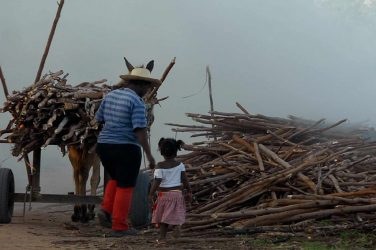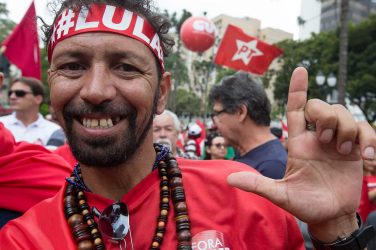On the Amazon frontier, where many people operate outside the law, you often hear locals speak in code — something journalists learn to listen for. So our ears pricked up as we prepared to film an interview in the office of Agamenom da Silva Menezes, president of the Novo Progresso Rural Farmers’ Union in Pará state.
A man had rushed in, speaking urgently to Agamenom without a glance at us: “They’re taking over the area. We need to do something. Right away.”
Agamenom raised a hand to silence the messenger and responded calmly: “OK. Don’t worry. We’ll talk later.” Then he turned to us and said abruptly: “Shall we begin?”
It was only later, when Agamenom described the activities of his union during the interview, that the penny dropped: the “something” the man mentioned was likely code for an illegal violent act; the forced eviction of “they” — settlers in the midst of a land occupation carried out by the Castelo de Sonhos Rural Workers Union, at a location known as “KM Mil.”
Showdown at KM Mil
Coincidentally, it was this landless peasant occupation that we’d come to talk with Agamemnon about. The so-called “KM Mil” settlement was located near the Thousand Kilometer marker on highway BR 163, a spot 1,000 kilometers from Cuiabá, the capital of Mato Grosso state.
Two days earlier we had visited the 80 families taking part in the occupation. They were living in rough shacks, with roofs covered in black plastic sheeting to keep out the rain.
Those shacks resembled hundreds of other temporary lean-tos that have sprung up across Brazil in the last 30 years as part of Brazil’s Landless Workers Movement (MST), and of other social movements trying to force authorities to carry out much-needed agrarian reform.
The KM Mil settlement, about 10 miles from the highway, was situated at the extreme edge of a large area of slashed-and-burned forest. The peasants had built their shacks right where the forest began and had started the hard work of clearing dense undergrowth and trees.
We’d arrived with Aloisio Sampaio, a trade unionist known as Alenquer, the primary leader of the occupation, so the settlers didn’t treat us with mistrust but spoke freely.
One settler explained why the community was moving into the forest: “Of course, we’d have like to have occupied the [already] cleared area, but it’s far too dangerous. It’s valuable land. People will fight tooth and nail to keep hold of it. People aren’t so interested in the forest.”
On examination, this may sound like bizarre logic, with deforested land and denuded soil deemed to be worth far more than exuberant, life-packed primary Amazon forest. But this is the way it is on the Amazon frontier, where cleared land, which can be sold to ranchers and farmers, is far more valuable (in dollars) than rainforest.
Until it is reversed, this way of thinking and acting will make it impossible to end the rampant forest destruction happening all over the region.
Landless Peasants Vs. Land Thieves
The settlers told us they would never think of moving into large, deforested areas. To do so would almost assuredly draw violence against them. So these landless Brazilians — whether part of official land colonization projects, or informal land occupations organized by social movements — are continually pushed deeper into the Amazon rainforest.
It is wealthy land operators who do the pushing. These politically connected land thieves, backed up by their violent “militias,” turn large stolen tracts into no-go areas — even when the land claimed and deforested is publicly owned (which it often is). The state rarely ever reclaims it, meaning that crime pays on the Amazon frontier.
This leaves landless peasants with little choice. If they wish to survive economically, they must clear virgin forest. But even that act benefits the land thieves: they use their influence to get officials from IBAMA, the federal environmental agency, to inspect the modest damage the settlers do to the forest, drawing attention away from the much greater harm the land thieves are causing with their own illegal land grabs
In the end, the big land thieves often win; they kick the hard-working peasant farmers off the land they’ve cleared, forcing them deeper into the forest. And so the cycle begins again.
Though far from being the main cause of Amazonian deforestation, this dynamic provides a graphic example of how life on the frontier typically works, with the wealthy dominating and exploiting the poor.
It is an upside-down world, argue many social critics: studies show that ironically the only legitimate claimants to Amazon public lands are the peasant families. This is because in the 1970s and 1980s large areas of the Amazon, including those currently in dispute, were set aside by the federal government specifically for the purpose of carrying out agrarian reform — but the program was never properly implemented.
Smoke and Mirrors on the Amazon Frontier
When we arrived at the KM Mil settlement, a woman was cooking lunch for a dozen people, some of whom had been clearing forest. She invited us to join them. While we ate, settler Ivanor da Silva Felizardo told us about his life: “I left Sinop [a town in Mato Grosso state on the BR-163] for lack of prospects. There was no way of getting on. Here everything is more raw; it’s possible to make something of your life. My luck was to get 100 hectares [247 acres] through the trade union.”
With the rural workers’ trade union organizing the landless occupation, the peasants felt they had some legitimacy and protection from violence: “The union is a legal organ,” Ivanor told us. “We have been here for about 90 days, and everything has gone well so far.” Even so, tension hung in the air. There were few women or children at the site, and some settlers admitted to often feeling afraid.
“They [the land thieves] want to get rid of me,” said leader Alenquer, who wears a flak jacket all the time. “They make threats against me on television, on radio, in the market, at home. I’ve got used to it. They don’t frighten me. And it won’t help them to kill me. We’ve trained various leaders along the BR-163. If they kill me, someone else will take my place.”
After lunch, another settler, who didn’t want to give his name, told us how the occupation had come about: a few years earlier, a man he called “the rightful owner” had been “forced off the land, by brute force” by a certain Tião, a much-feared gunman from the AJ Vilela gang. “After [Tião] took over, hardly anyone who set foot in here returned alive,” he said.
There were many murders, the settler told us. But after the arrest of AJ Vilela in 2016 by federal police, the land’s “rightful owner” reappeared. He was keen to regain control of his land, so came to the rural trade union with a proposal: he would give the peasants some land to keep and clear. The peasants were surprised at this act of generosity, but believed “the rightful owner” was a good man who simply wanted to help them.
“We signed a contract, it’s all legalized,” the settler told us. “We are very happy. It’s going to work out well.”
However, things were more complicated than first appeared. The settlers learned later that “the rightful owner” wasn’t the only one eying this valuable piece of real estate that had become “available” after the arrest of the gang. And despite calling himself “the rightful owner,” the man behind the deal was, in fact, just another land thief — the first to occupy the land illegally before being driven off by the more powerful and violent AJ Vilela gang.
The “rightful owner” refused to be interviewed, saying that publicity would make it more likely that he would be assassinated, but it became clear to us that he likely planned to use the landless peasants as pawns and a human shield. He knew the settlers were determined to keep their plots and would defend their camp fiercely. This was a good deal for the “owner”: if the peasants drove off the militias hired by other land thieves, then he would get to keep an extremely valuable area of cleared land, while “giving” the settlers a relatively small piece of forest.
Enter Agamenom
Our interview with Agamenom signaled to us that the settlers would not find it easy to hang on to the land they’d claimed. To him, the peasant families were “invaders” who had to be evicted, whatever the cost.
Though reluctant to talk about KM Mil specifically, Agamenom spoke frankly about how he used militias made up of hired thugs to resolve situations of this nature: “If they [the settlers] leave on their own accord, fine. If they won’t go, we make them. We do what it takes. If they use clubs against us, we use clubs. If they use knives, we use knives. If they use dogs, we use dogs … the way it is done depends on them … but in the end we get them out.”
It was surprising to find that Agamenom was willing to talk so openly on camera about sending in his own militia — utterly illegal in Brazil. But since the fall of President Dilma Rousseff’s government and the rise of the agribusiness-friendly Temer government, land speculators appear emboldened, stating brazenly that they operate above the law.
Agribusiness-friendly Temer government, land speculators appear emboldened, stating brazenly that they operate above the law.
Indeed, Agamenom and his fellow speculators openly revealed their plans in the local media. This is what the local newspaper, sympathetic to Agamenom, wrote at the time:
Farmers are preparing to mobilize to defend property rights, which they see as threatened by the ineffectiveness of the federal authorities in the region. Their first action will take place in the next few days when they intend to evict those who have illegally occupied land by KM Mil.
The following day, a group of six armed men attacked the camp, firing shots in the air and shouting threats. No one was injured and the settlers believed that the gunmen only intended to intimidate them. Before the men left, they promised to return shortly and told the peasants to prepare for something much worse.
But Alenquer, highly experienced in these sorts of clashes, made an unusual move: in January 2017 he published a YouTube video in which he accused Agamenom Menezes and Neri Prazeres, the former mayor of Novo Progresso, of being land thieves and of threatening to kill him. The two denied his charges and have said they will sue him for defamation. But the attacks on the camp have stopped, for now, probably because of the publicity.
“Everyone Here Is a Land Thief”
Conflicts of the kind described here are common today on the Amazon frontier, where land thieving is the easiest, quickest way to make money. Possibly to play down his own land grabbing activities, Agamenom told us: “We are all land thieves here! There is no citizen who is not a land thief, because we are all illegally occupying federal land.”
Cattle rancher Lincoln Queiroz Brasil argues otherwise, noting that he is not a land thief. In the late 1970s and 80s, impoverished families, largely from southern Brazil, arrived in Novo Progresso by way of the just opened BR-163. Many signed contracts with INCRA, the land colonization institute, agreeing to pay for land plots in ten annual installments.
The Queiroz were one of those families, and Lincoln told us that he remembers his scrupulously honest father traveling each year to Itaituba on the Tapajós river, at the time a difficult journey, to make the payment. But many families didn’t bother paying.
Despite the exceptions, Agamenom is right to suggest that land thieving is very common.
The absence of a strong law enforcement presence in the region has resulted in land thieves taking over huge tracts of public land, some covering tens of thousands of acres. Agamenom himself bragged to us of being the “owner” of 70,000 hectares (173,000 acres) in 2004 — even though it’s illegal to claim such vast areas under the Brazilian Constitution, which sets a maximum size for any public land plot held by a private individual at 2,500 hectares (6,177 acres). Anything larger than that requires congressional authorization.
Beating the Constitution
Land thieves have found a way round the Brazilian Constitution: they divide the tract they want to “own” into subplots, each about 2,500 hectares in size. Then they get another individual — famously called a laranja (an orange), probably because an orange is made up of a number of segments — to register the subplot in his or her name.
Queiroz said that you can easily purchase a so-called “Citizen Kit” in Novo Progresso which provides all the required documents to become a laranja — an identity card, electoral registration, and so on.
The person named in the kit puts him or herself forward as the “owner” of the land, should IBAMA ever come round asking questions or seeking a fine for deforestation. This “owner” is always a very poor person, who is pleased to earn a pittance for his or her participation in the scheme. That’s why the kits are very cheap: “If you’re a friend of the supplier, you might even be given it for nothing,” laughed Queiroz.
Over the last decade, the perpetrators of land theft have changed. In the past, cattle ranchers were likely to grab land for their ranches. Now the name of the game is forest clearance.
Queiroz explained to us how “speculative clearance” works — the name given to the illegal practice by IMAZON, the Institute for Man and the Environment in Amazonia. “A person takes over a forested area [usually on public land] and fells the forest. He doesn’t want to produce anything on this land, but merely to get it ready for selling on,” said Queiroz. “And, just by clearing the land, he increases the value of the land 100 or 200 times.”
The buyers of this newly cleared land will usually raise cattle. These purchasers range from large landowners coming from Mato Grosso or Goiás, who are fully aware of the illegality of their purchase, to more naïve small-scale farmers who have sold everything they own elsewhere to buy what they falsely believe to be a properly registered property in the Amazon.
In the process, the land speculators make huge profits, with each tract of stolen land bringing in, on average, R$20 million (US$6.4 million), according to calculations by the MPF, the independent Public Federal Ministry.
And so it is that land theft, once carried out by cattle ranchers or crop growers, has become divorced from farming. It is now through illegal “speculative clearance” of public lands that the big money is to be made. Thus, deforestation becomes a business in its own right.
Queiroz told us that “the largest deforesters in the region do not own a single head of cattle.” His comment is backed up by a recently published study, showing that those clearing forest along the Novo Progresso section of the BR-163 haven’t planted or created anything, except spectacular profits for themselves coming from the huge boom in the value of cleared Amazon real estate.
The Amazon deforestation racket has gained so much momentum, and become so lucrative, that, after engaging in it for over a decade, one famous land speculator, Ezequiel Castanha, brazenly began offering a turnkey operation: he formed a “partnership” with a person who had taken over a large area of forest, providing him with everything he needed to clear the tract — “oranges” with documentation, poor laborers to cut trees and to seed pastures, and much more. At the end, when the land was sold, Castanha took a hefty share of the profits.
Eventually, Castanha was arrested in Operation Castanheira (named after him), which was carried out by the Federal Public Ministry (MPF), the Federal Police and IBAMA.
Deforestation in the Novo Progresso region is on the rise — as it has been for the last two years throughout the Amazon. And rainforest prospects are not good: at the end of March, the Temer government slashed by over 50 percent the budget of the Ministry of the Environment, which is responsible for both IBAMA and the Chico Mendes Institute of Biodiversity Conservation (ICMBio), which runs the federal government’s conservation units.
That means that the already understaffed forces protecting the Amazon will be even smaller in the coming year. For the rainforest and the landless peasants this is likely bad news. For the land thieves, this is very good news.
This article appeared originally in Mongabay – https://news.mongabay.com














